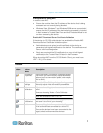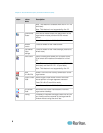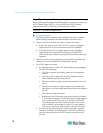
Chapter 2: Virtual KVM Client (VKC) and Active KVM Client (AKC)
5
About the Virtual KVM Client
Whenever you access a target server using the Remote Console, a
Virtual KVM Client (VKC) window opens. There is one Virtual KVM Client
for each target server connected. These windows can be accessed via
the Windows
®
task bar.
Note: Some features, such as client launch settings and smart cards, are
not supported by the LX and, as such, are not supported by AKC or VKC
when used in conjunction with the LX.
Note: The KX II-101-V2 only supports a connection to one target at a
time.
Virtual KVM Client windows can be minimized, maximized, and moved
around your computer desktop.
Note: Refreshing your HTML browser closes the Virtual KVM Client
connection, so exercise caution.
Note: If you are using Firefox 3.0.3, you may experience problems
launching the application. If this occurs, clear the browser cache and
launch the application again.
About the Active KVM Client
The Microsoft Windows .NET-based Active KVM Client (AKC) is
available in the KX II 2.2 (and later) and LX 2.4.5 (and later). AKC can be
used with all KX II and LX models. The KX2-101 and KX II-101-V2 is not
supported.
AKC is based on Microsoft Windows .NET technology and allows you to
run the client in Windows environments without the use of the Java
Runtime Environment (JRE), which is required to run Raritan's Virtual
KVM Client (VKC) and Multi-Platform Client (MPC). AKC also works with
CC-SG.
Note: Some features, such as client launch settings and smart cards, are
not supported by the LX and, as such, are not supported by AKC or VKC
when used in conjunction with the LX.
Note: If you are using direct port access with AKC, you must open a new
browser window or browser tab for each target you want to access. If you
try to access another target by entering the DPA URL into the same
browser window or browser tab you are currently accessing a target
from, you will not be able to connect and may receive an error.


















